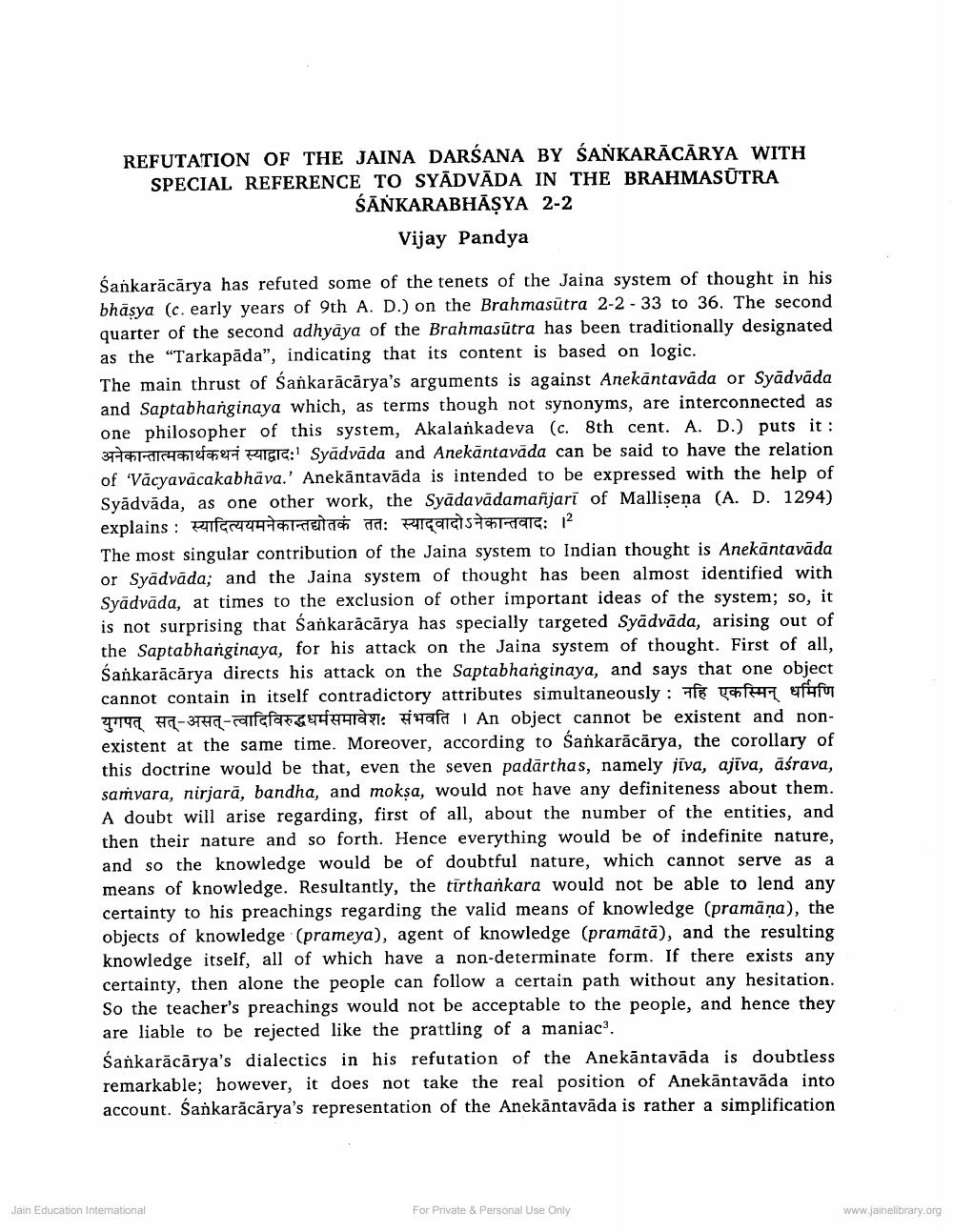________________
REFUTATION OF THE JAINA DARSANA BY SANKARĀCĀRYA WITH SPECIAL REFERENCE TO SYĀDVĀDA IN THE BRAHMASŪTRA
ŚĀNKARABHĀŞYA 2-2
Vijay Pandya
Śankarācārya has refuted some of the tenets of the Jaina system of thought in his bhāsya (c. early years of 9th A. D.) on the Brahmasutra 2-2 - 33 to 36. The second quarter of the second adhyāya of the Brahmasūtra has been traditionally designated as the “Tarkapāda", indicating that its content is based on logic. The main thrust of Sankarācārya's arguments is against Anekantavada or Syadvāda and Saptabhanginaya which, as terms though not synonyms, are interconnected as one philosopher of this system, Akalańkadeva (c. 8th cent. A. D.) puts it : 31-01-C4 Tech PIETS: Syädvāda and Anekantavāda can be said to have the relation of 'Vācyavācakabhāva.' Anekāntavāda is intended to be expressed with the help of Syādvāda, as one other work, the Syādavādamañjarī of Mallisena (A. D. 1294) explains : fauna da: Ricaraistattare: 12 The most singular contribution of the Jaina system to Indian thought is Anekantavāda or Syādvāda; and the Jaina system of thought has been almost identified with Syädvāda, at times to the exclusion of other important ideas of the system; so, it is not surprising that śankarācārya has specially targeted Syādvāda, arising out of the Saptabhanginaya, for his attack on the Jaina system of thought. First of all, Sankarācārya directs his attack on the Saptabhanginaya, and says that one object cannot contain in itself contradictory attributes simultaneously : f afe ufufu
-376-afca 9 91: Yafa | An object cannot be existent and nonexistent at the same time. Moreover, according to śankarācārya, the corollary of this doctrine would be that, even the seven padārthas, namely jīva, ajīva, āśrava, saṁvara, nirjarā, bandha, and mokşa, would not have any definiteness about them. A doubt will arise regarding, first of all, about the number of the entities, and then their nature and so forth. Hence everything would be of indefinite nature, and so the knowledge would be of doubtful nature, which cannot serve as a means of knowledge. Resultantly, the tirthankara would not be able to lend any certainty to his preachings regarding the valid means of knowledge (pramāna), the objects of knowledge (prameya), agent of knowledge (pramātā), and the resulting knowledge itself, all of which have a non-determinate form. If there exists any certainty, then alone the people can follow a certain path without any hesitation. So the teacher's preachings would not be acceptable to the people, and hence they are liable to be rejected like the prattling of a maniac?. Sankarācārya's dialectics in his refutation of the Anekāntavāda is doubtless remarkable; however, it does not take the real position of Anekāntavāda into account. Sankarācārya's representation of the Anekāntavāda is rather a simplification
Jain Education International
For Private & Personal Use Only
www.jainelibrary.org




